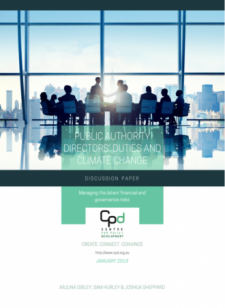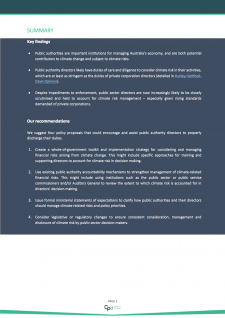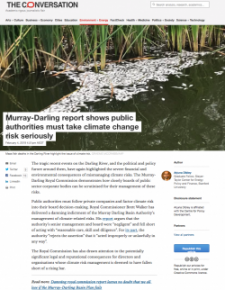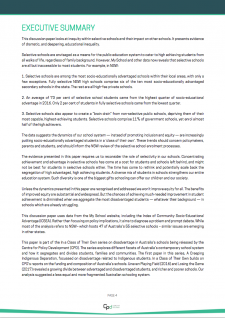Centre for Policy Development's Blog, page 26
February 10, 2019
CPD brings Professor Mariana Mazzucato to Australia | December 2018
The post CPD brings Professor Mariana Mazzucato to Australia | December 2018 appeared first on Centre for Policy Development.
February 4, 2019
Murray-Darling report shows public authorities must take climate change risk seriously | Op-ed | Arjuna Dibley
Published in The Conversation on 4 February 2019.
The tragic recent events on the Darling River, and the political and policy furore around them, have again highlighted the severe financial and environmental consequences of mismanaging climate risks. The Murray-Darling Royal Commission demonstrates how closely boards of public sector corporate bodies can be scrutinised for their management of these risks.
Public authorities must follow private companies and factor climate risk into their board decision-making. Royal Commissioner Brett Walker has delivered a damning indictment of the Murray Darling Basin Authority’s management of climate-related risks. His report argues that the authority’s senior management and board were “negligent” and fell short of acting with “reasonable care, skill and diligence”. For its part, the authority “rejects the assertion” that it “acted improperly or unlawfully in any way”.
The Royal Commission has also drawn attention to the potentially significant legal and reputational consequences for directors and organisations whose climate risk management is deemed to have fallen short of a rising bar.
It’s the public sector’s turn
Until recently, scrutiny of how effectively large and influential organisations are responding to climate risks has focused mostly on the private sector.
In Australia it is widely acknowledged among legal experts that private company directors’ duty of “due care and diligence” requires them to consider foreseeable climate risks that intersect with the interests of the company. Indeed, Australia’s companies regulator, ASIC, has called for directors to take a “probative and proactive” approach to these risks.
The recent focus on management of the Murray-Darling Basin again highlights the crucial role public sector corporations (or “public authorities” as we call them) also play in our overall responses to climate change – and the consequences when things go wrong.
Australia’s economy, once dominated by publicly owned enterprises, was reshaped by waves of privatisations in the late 20th century. However, hundreds of public authorities continue to play an important role in our economy. They build and maintain infrastructure, generate energy, oversee superannuation portfolios, provide insurance and manage water resources, among many other activities.
This means that, like their counterparts in the private sector, many face risks associated with climate change. Take Melbourne Water, for instance, a statutory water corporation established to manage the city’s water supply. It will have to contend with increasingly hot summers and reduced rainfall (a physical risk), and also with the risk that government policy in the future might impose stricter conditions on how water is used (a transition risk).
What duties do public authorities owe?
Our new research from the Centre for Policy Development, shows that, at the Commonwealth and Victorian level (and likely in other Australian jurisdictions), the main laws governing officials in public authorities are likely to create similar obligations to those imposed on private company directors.
For instance, a 2013 federal act requires public authority board members to carry out their duties with the degree of “due care and diligence” that a reasonable person would exercise if they were a Commonwealth official in that board position.
The concept of a “reasonable person” is crucial. There is ever-increasing certainty about the human contribution to climate change. New tools and models have been created to measure the impact of climate change on the economy. Climate risks are therefore reasonably foreseeable if you are acting carefully and diligently, and thus public authority directors should consider these risks.
The obligations of public authority directors may, in some cases, go beyond what is required of private company directors. The same act mentioned above requires Commonwealth officials to promote best practice in the way they carry out their duties. While there is still wide divergence in how private companies manage climate change, best practice in leading corporations is moving towards more systematic analysis and disclosure of these risks. Accordingly, a “best practice” obligation places an even higher onus on public sector directors to manage climate risk.
The specific legislation that governs certain public authorities may introduce different and more onerous requirements. For instance, the Murray-Darling Basin Authority’s governing legislation, the Water Act 2007, imposes a number of additional conditions on the authority. This includes the extent to which the minister can influence board decision-making.
Nonetheless, our laws set out a widely applicable standard for public authority directors.
Approaches to better manage public authority climate risks
While some public authorities are already carefully considering how physical and transition climate risks affect their work, our research suggests that standards vary widely.
As with the private sector, a combination of clear expectations for better climate risk management, greater scrutiny and more investment in climate-related capabilities and risk-management frameworks can all play a role in raising the bar. Our research highlights four steps that governments should consider:
creating a whole-of-government toolkit and implementation strategy for training and supporting directors to account for climate-risk in decision-making
using existing public authority accountability mechanisms – such as the public sector commissioner or auditor general’s office – to more closely scrutinise the management of climate-related financial risks
issuing formal ministerial statements of expectations to clarify how public authorities and their directors should manage climate-related risks and policy priorities
making legislative or regulatory changes to ensure consistent consideration, management and disclosure of climate risk by public sector decision-makers.
Read more: Company directors can be held legally liable for ignoring the risks from climate change
Measures such as these would set clear expectations for more consistent, sophisticated responses to climate risks by public authorities. However, even without any changes, it should be clear that public authority directors have legal duties to consider climate risks – and that these duties must be taken seriously even when doing so is complicated, controversial or politically sensitive.
The post Murray-Darling report shows public authorities must take climate change risk seriously | Op-ed | Arjuna Dibley appeared first on Centre for Policy Development.
February 3, 2019
Public authority directors’ duties and climate change | DISCUSSION PAPER | January 2019

CPD has released a new discussion paper on the legal obligations of public sector corporate boards and directors to consider climate-related risks. Public authority directors’ duties and climate change finds that these directors likely have duties of care and diligence to consider climate risk which are at least as stringent as the duties of private corporation directors. Its authors are Arjuna Dibley, Sam Hurley and Joshua Sheppard.
Earlier CPD work has explored the obligations of company directors in the private sector to respond to climate-related risks. The highly influential Hutley-Hartford Davis legal opinion on climate risks, which we commissioned in 2016, emphasised that directors who do not properly consider and disclose foreseeable climate-related risks could be held liable for breaching their legal duties. This finding has been echoed by Australia’s financial and corporate regulators, including the Australian Securities and Investments Commission, whose Commissioner John Price told a CPD audience in 2018 that company directors should take a “proactive and probative” approach to climate risk.
While the bar has been rising in the private sector, the responsibilities of directors in public sector authorities to consider climate in their decision making have attracted less attention. However, like major companies, many public sector authorities play a critical role in our economy: they build and maintain infrastructure, oversee superannuation portfolios, provide insurance and manage water resources, among many other activities. And just like private sector counterparts, many are likely to be subject to financial risks associated with climate change, not to mention reputational and other risks should they fail to take appropriate action
Key findings
Public authorities are important institutions for managing Australia’s economy, and are both potential contributors to climate change and subject to climate risks.
Public authority directors likely have duties of care and diligence to consider climate risk in their activities, which are at least as stringent as the duties of private corporation directors (detailed in Hutley-Hartford-Davis Opinion).
Despite impediments to enforcement, public sector directors are now increasingly likely to be closely scrutinised and held to account for climate risk management – especially given rising standards demanded of private corporations.
Recommendations
While some public authorities are responding in a sophisticated way to climate risk, changes are needed to support wider adoption of best-practice approaches. Our paper makes four recommendations that could help boards and directors to better manage climate risks, ranging from measures working within current accountability frameworks to new legislated standards and requirements. These are:
Create a whole-of-government toolkit and implementation strategy for considering and managing financial risks arising from climate change. This might include specific approaches for training and supporting directors to account for climate risk in decision making.
Use existing public authority accountability mechanisms to strengthen management of climate-related financial risks. This might include using institutions such as the public sector or public service commissioners and/or Auditors General to review the extent to which climate risk is accounted for in directors’ decision making.
Issue formal ministerial statements of expectations to clarify how public authorities and their directors should manage climate-related risks and policy priorities.
Consider legislative or regulatory changes to ensure consistent consideration, management and disclosure of climate risk by public sector decision makers
These findings and recommendations were discussed and refined as part of a roundtable hosted by CPD, Minter Ellison and the Office of the Commissioner for Environmental Sustainability, Vitoria, which drew on insights from public sector board directors, governance experts and climate specialists. The research which underpins the paper was developed in part through an internship program supported by Monash University’s Faculty of Law.
Key Documents



Full discussion paper
Summary
The Conversation article
Coverage and related reading
Murray Darling report shows public authorities must take climate change risk seriously, Arjuna Dibley, The Conversation, 4 February 2019.
Murray-Darling Basin Royal Commission Report, 29 January 2019 and the Murray-Darling Basin Authority response to these findings, 31 January 2019
Why company directors have started caring about climate change, Nassim Khadem, ABC News, 25 October 2018
ASIC puts directors on notice over disclosure on climate change risks, Michael Roddan, The Australian, 19 June 2018
CPD roundtable on directors duties, climate risks and sustainability, October 2016
Legal opinion on directors duties and climate change, Noel Hutley SC and Sebastian Hartford-Davis, October 2016
Legal advice on NAIF investment in Adani coal infrastructure, Australian Conservation Foundation, April 2017
‘Climate change’, ASIC Commissioner John Price’s address to CPD Forum, July 2018.
The post Public authority directors’ duties and climate change | DISCUSSION PAPER | January 2019 appeared first on Centre for Policy Development.
Public authority directors’ duties and climate change | DISCUSSION PAPER | January 2018

CPD has released a new discussion paper on the legal obligations of public sector corporate boards and directors to consider climate-related risks. Public authority directors’ duties and climate change finds that these directors likely have duties of care and diligence to consider climate risk which are at least as stringent as the duties of private corporation directors. Its authors are Arjuna Dibley, Sam Hurley and Joshua Sheppard.
Earlier CPD work has explored the obligations of company directors in the private sector to respond to climate-related risks. The highly influential Hutley-Hartford Davis legal opinion on climate risks, which we commissioned in 2016, emphasised that directors who do not properly consider and disclose foreseeable climate-related risks could be held liable for breaching their legal duties. This finding has been echoed by Australia’s financial and corporate regulators, including the Australian Securities and Investments Commission, whose Commissioner John Price told a CPD audience in 2018 that company directors should take a “proactive and probative” approach to climate risk.
While the bar has been rising in the private sector, the responsibilities of directors in public sector authorities to consider climate in their decision making have attracted less attention. However, like major companies, many public sector authorities play a critical role in our economy: they build and maintain infrastructure, oversee superannuation portfolios, provide insurance and manage water resources, among many other activities. And just like private sector counterparts, many are likely to be subject to financial risks associated with climate change, not to mention reputational and other risks should they fail to take appropriate action
Key findings
Public authorities are important institutions for managing Australia’s economy, and are both potential contributors to climate change and subject to climate risks.
Public authority directors likely have duties of care and diligence to consider climate risk in their activities, which are at least as stringent as the duties of private corporation directors (detailed in Hutley-Hartford-Davis Opinion).
Despite impediments to enforcement, public sector directors are now increasingly likely to be closely scrutinised and held to account for climate risk management – especially given rising standards demanded of private corporations.
Recommendations
While some public authorities are responding in a sophisticated way to climate risk, changes are needed to support wider adoption of best-practice approaches. Our paper makes four recommendations that could help boards and directors to better manage climate risks, ranging from measures working within current accountability frameworks to new legislated standards and requirements. These are:
Create a whole-of-government toolkit and implementation strategy for considering and managing financial risks arising from climate change. This might include specific approaches for training and supporting directors to account for climate risk in decision making.
Use existing public authority accountability mechanisms to strengthen management of climate-related financial risks. This might include using institutions such as the public sector or public service commissioners and/or Auditors General to review the extent to which climate risk is accounted for in directors’ decision making.
Issue formal ministerial statements of expectations to clarify how public authorities and their directors should manage climate-related risks and policy priorities.
Consider legislative or regulatory changes to ensure consistent consideration, management and disclosure of climate risk by public sector decision makers
These findings and recommendations were discussed and refined as part of a roundtable hosted by CPD, Minter Ellison and the Office of the Commissioner for Environmental Sustainability, Vitoria, which drew on insights from public sector board directors, governance experts and climate specialists. The research which underpins the paper was developed in part through an internship program supported by Monash University’s Faculty of Law.
Key Documents


Full discussion paper
Summary
Op-ed coming soon.
Coverage and related reading
Murray-Darling Basin Royal Commission Report, 29 January 2019 and the Murray-Darling Basin Authority response to these findings, 31 January 2019
Why company directors have started caring about climate change, Nassim Khadem, ABC News, 25 October 2018
ASIC puts directors on notice over disclosure on climate change risks, Michael Roddan, The Australian, 19 June 2018
CPD roundtable on directors duties, climate risks and sustainability, October 2016
Legal opinion on directors duties and climate change, Noel Hutley SC and Sebastian Hartford-Davis, October 2016
Legal advice on NAIF investment in Adani coal infrastructure, Australian Conservation Foundation, April 2017
‘Climate change’, ASIC Commissioner John Price’s address to CPD Forum, July 2018.
The post Public authority directors’ duties and climate change | DISCUSSION PAPER | January 2018 appeared first on Centre for Policy Development.
January 29, 2019
Separating Scholars | DISCUSSION PAPER | January 2019

EXECUTIVE SUMMARY
This discussion paper analyses how schools are changing over time, especially in terms of enrolment characteristics and the school achievement measures and results most familiar to parents and teachers. The analysis uses end-of-school measures of student achievement and focusses on New South Wales, Victoria and Queensland, to show the relationship between school achievement and other school characteristics, including level of student advantage and location. Increasingly, we can see high achievers concentrated in the most advantaged schools, while those in lower SES schools are facing falling achievement levels.
The findings are replicated, in different ways, across the three states. In New South Wales in 2017, the proportion of HSC Distinguished Achievers (DAs) from the highest ICSEA schools was 19%, whereas in the lowest ICSEA schools it was 1%. In Victoria, this pattern is repeated, with the proportion of students with a VCE score of 40 or over is 24% in the highest ICSEA band but only 2.2% in the lowest. In Queensland 85% of the highest achievers come from schools above ICSEA 1000, 15% from the schools below.
Even more significantly, such gaps have been widening over the last decade. In NSW, the schools in the  highest ICSEA band have markedly increased their numbers and proportion of DAs since 2005/06. This has been accompanied by a change in the distribution of enrolments to these schools, so that increasingly the most advantaged students are going to the most advantaged schools. In all three states, schools in the highest ICSEA band have increased the proportion of students from the highest SEA quarter, so that that Queensland (+6%), Victoria (+8%) and NSW (+13%) have all seen a concentration of high SEA students into the most advantaged schools.
highest ICSEA band have markedly increased their numbers and proportion of DAs since 2005/06. This has been accompanied by a change in the distribution of enrolments to these schools, so that increasingly the most advantaged students are going to the most advantaged schools. In all three states, schools in the highest ICSEA band have increased the proportion of students from the highest SEA quarter, so that that Queensland (+6%), Victoria (+8%) and NSW (+13%) have all seen a concentration of high SEA students into the most advantaged schools.
At the same time, the reverse is true, with the lowest ICSEA schools in Queensland (+10%), Victoria (+3%) and NSW (+9%) each seeing an increase in the number of students from the lowest SEA quarter. These factors are creating a system that concentrates advantage and disadvantage in different types of schools, with obvious flow on effects for achievement levels of those students. There is also a stark difference between the cities and regional areas, with the proportion of DAs in major cities in NSW at 23%, but only 2.3% in inner regional areas, and just 0.3% in outer regional areas.
The data suggest that achievement outcomes are becoming increasingly connected to the level of advantage of the school a student attends, so that some of the differences in achievement among schools may simply reflect who is enrolled – and how this enrolment is changing – rather than the quality of teaching.
These enrolment trends mean that students who are already advantaged are concentrating in high achieving schools, while the disadvantaged are being segregated into struggling schools, so that the burden of lifting up the most disadvantaged is not evenly spread across schools, sectors and locations.
This paper is part of CPD’s In a Class of Their Own series on disadvantage in Australia’s schools. The series explores different facets of Australia’s contemporary school system and how it segregates and divides students, families and communities. The first paper in this series, A Creeping Indigenous Separation, focussed on disadvantage related to Indigenous students. The second paper, Institutionalised Separation (Jul 2018) by Christina Ho with Chris Bonnor, looked at inequity within selective schools and their impact on other schools.
In a Class of Their Own builds on CPD’s reports on the funding and composition of Australia’s schools. Uneven Playing Field (2016) and Losing the Game (2017) revealed a growing divide between advantaged and disadvantaged students, and richer and poorer schools. Our analysis suggested a less equal and more fragmented Australian schooling system.
Key Documents



Full discussion paper
Executive Summary
Press release
Media coverage
‘Winners and losers’: school shopping widens education gap, The Sydney Morning Herald, Jordan Baker.
ABC Radio, Natasha Robinson.
The gap between wealthy and disadvantaged schools is widening, research shows, SBS News, Maani Truu,
Key links and related reading
Institutionalised Separation, CPD Discussion Paper 2018, Christina Ho in association with Chris Bonnor.
A Creeping Indigenous Separation, CPD Discussion Paper 2018, Chris Bonnor, Christina Ho and Garry Richards.
Has Gonski stepped outside the square?, Inside Story, Chris Bonnor.
Selective school decisions coming back to haunt us, The Sydney Morning Herald, Christina Ho and Chris Bonnor.
Losing The Game: State of our Schools in 2017, CPD Report 2017, Chris Bonnor and Bernie Shepherd.
Uneven playing field: the state of Australia’s schools, CPD Report 2016, Chris Bonnor and Bernie Shepherd.
Time to seriously review selective schools, The Sydney Morning Herald, Christina Ho and Chris Bonnor.
‘Absolute prize’: Why selective schools are eclipsing private schools, The Sydney Morning Herald, Jordan Baker.
Selective schools must promote equity and inclusion, The Sydney Morning Herald, Editorial.
‘I can see why people are worried’: Have we hit peak selective?, The Sydney Morning Herald, Jordan Baker.
The post Separating Scholars | DISCUSSION PAPER | January 2019 appeared first on Centre for Policy Development.
January 21, 2019
Employment Services Report 2020 | Expert Advisory Panel | January 2019
The post Employment Services Report 2020 | Expert Advisory Panel | January 2019 appeared first on Centre for Policy Development.
Future of Employment Services | CPD SUBMISSION | August 2018
The post Future of Employment Services | CPD SUBMISSION | August 2018 appeared first on Centre for Policy Development.
January 17, 2019
John Menadue Oration by Mariana Mazzucato – Can the State deliver? | 11 December 2018
The post John Menadue Oration by Mariana Mazzucato – Can the State deliver? | 11 December 2018 appeared first on Centre for Policy Development.
Public Forum: Mission-led Innovation | 13 December 2018

On 13 December, CPD, the City of Melbourne and the Monash Sustainable Development Institute co-hosted a public forum with Mariana Mazzucato on the topic XYZ. At this biggest public event in Melbourne, Professor Mazzucato took her ideas to another sold out public audience of over 200 people. She focused especially on the interplay between mission-led innovation, inclusive growth and cities. Mariana’s keynote address was followed by a discussion with Sarah Pearson, Chief Innovation Officer in the Department of Foreign Affairs and Trade and John Thwaites, Chair of the MSDI, moderated by Glyn Davis.
In the discussion, recurring themes about the importance of the Sustainable Development Goals as a set of big challenges increasingly common across many countries and the need for much bolder and more diverse collaboration between the public sector, businesses, innovators and entrepreneurs were drawn out and emphasised.
VIDEO
The post Public Forum: Mission-led Innovation | 13 December 2018 appeared first on Centre for Policy Development.
CEDA-Monash-CPD lunch: Rethinking Business | 14 December 2018

Sam Mostyn, Clare O’Neil MP, Mariana Mazzucato, Melinda Cilento
On 14 December, the Committee for the Economic Development of Australia (CEDA) in collaboration with Monash University and the Centre for Policy Development presented a unique opportunity to hear from Mariana Mazzucato speaking to an Australian senior business audience.
In the final event of the week, Mariana address a packed business lunch of over 200 people hosted by CEDA. After her speech, Mariana was joined for a panel discussion by Claire O’Neill, Shadow Minister for Justice and Financial Services, CPD Board member Sam Mostyn and CEDA CEO Melinda Cilento, followed by audience Q&A.
Familiar themes came up in the discussion around mission-driven innovation and the importance of the stories we tell ourselves (or don’t tell) about the value and significance of public investment and the public sector in innovation and sustainable growth. To this were added critical insights into the role of business and the idea of mutual obligation between government and business to focus investments on delivering public value and long-term, sustainable and inclusive growth.

Meet the panel

Clare O’Neil MP
Shadow Federal Minister for Financial Services
Clare O’Neil was elected to the Parliament as the Federal Member for Hotham in 2013, and was re-elected in 2016. Immediately before entering Parliament, Clare worked in business as an Engagement Manager at McKinsey & Company. She is also a former Mayor of Greater Dandenong, and was Australia’s youngest ever female Mayor.

Sam Mostyn
Non-Executive Director, Citibank Australia, Transurban, Virgin Australia, Mirvac
Sam Mostyn is a non-executive director and sustainability adviser and speaker. Her current board roles include Mirvac, Transurban and Virgin Australia. She is the Chair of Citi Australia. Her corporate roles have encompassed human resources and culture change, corporate and government affairs, community engagement and corporate sustainability.

Melinda Cilento
Chief Executive, CEDA
Melinda Cilento is an economist, experienced executive and company director. She has served as a Commissioner with the Productivity Commission, in senior roles in Federal Treasury and as Chief Economist and Deputy CEO at the Business Council of Australia.
The post CEDA-Monash-CPD lunch: Rethinking Business | 14 December 2018 appeared first on Centre for Policy Development.
Centre for Policy Development's Blog
- Centre for Policy Development's profile
- 1 follower



